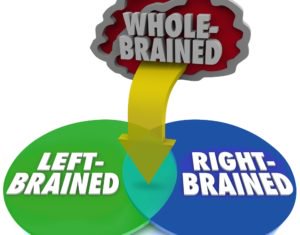
Maintaining agility in a competitive world demands a knowledge of management. We need to look through the lens of history to see what has worked in the past, and we want data to assist in our future decision-making. We also must find reasonable ways to manage our company with informed perspectives of what has worked (or not) and what type of flexibility and new concepts are warranted.
I recently scoured a research report by Accenture—Striking Balance With Whole-Brain Leadership. Through interviews with more than 200 C-suite leaders and over 11,400 customers and employees, it looked at the thinking styles found in organizations and compared them with the styles valued by customers and employees. Not surprisingly, the two didn’t always match up.
The focus of the research was management qualities that are either left-brained or right-brained. The takeaway? We need to develop a greater whole-brain approach to our organizational leadership skills.
Just the facts, please
Since most people reading this report are C-suite leaders of the left-brain persuasion, let’s look at two relevant details:
- 89% of C-suite leaders have degrees in traditionally left-brained courses of study: business, science, and technology. These fields of study focus on the value of statistics and data, which are critical for decision-making.
- C-suite execs who adopt a whole-brain approach to company leadership see, on average, revenue growth of 22% and higher profits of 34%.
With these research results, a whole-brain approach is certainly worth considering, but we need to understand what is driving the change—businesses facing disruption, both externally and internally. For our purposes, internal disruptors are employees who value a broader whole-brain approach to management. This group, dubbed Pathfinders, is bold and looking for positive change with the goal of making their companies better.
The report identifies large differences between the perceptions of goal-driven Pathfinders and the perceptions of C-suite executives. When people were asked which leadership qualities are important for high-level business executives, the obvious left-brained qualities of organization, leadership, foresight, and planning were in sync. Both the dynamic Pathfinders and the C-suite executives value those abilities and consider them important for business success.
Other Articles From AllBusiness.com:
In contrast, when right-brain attributes were considered, there appears to be a huge gap. Pathfinders expect C-suite executives to demonstrate high functionality in areas attributed to right-brained qualities: intuition, inclusiveness, creativity, and empathy. However, the C-suite executives did not rate these qualities as high.
For C-suite managers trained to make data-driven decisions, this type of internal disruption of expectations regarding leadership can be a bit intimidating. We can see that we are limited, not only by our own training, but also by our view of what is needed in the organization. It is a time for self-reflection (yes, that’s a bit right-brained) and action to effectively address organization leadership needs to meet disruption head-on and remain relevant in our markets.
Become an ambidextrous organization
Given the tendency for corporate management to be trained in left-brain analytics, turning to disruptors like Pathfinders can offer companies a right-brain perspective. Pathfinders will push for change, demonstrate creativity, tend to believe in social responsibility, and still offer those highly valued critical skills. If we can collaborate with them, they can bring value to a company.
Becoming a company that is flexible in its thinking will help develop elements on both sides of the brain. That is not to say that a C-suite manager will become empathetic, but a good leader will find ways to incorporate an appreciation for whole-brain management. Here is how:
- Train internally to develop a broader skill set to broaden employee thinking styles. Developing flexibility will create a more diverse and resilient company.
- Hire different styles of thinkers. Fill in gaps from the outside to improve management capabilities within.
- Ally with Pathfinders. Eschew traditional paths; instead, listen and incorporate this value group’s ideas. This doesn’t mean a lack of traditional structure but, rather, a more open path for getting good ideas implemented.
- Use internal prospects with whole-brain finesse to take on growth projects and exemplify what works to create growth and profit. As others see the thinking being rewarded, they are more likely to broaden their brain abilities in the workplace.
With so many interviews on this topic, there is substantial information to digest. As a company, our success is dependent upon broad thinking strategies that complement our own analytical styles and those of our value Pathfinders. Choosing to take a whole-brain approach to decision-making and leadership will pay off with more engaged employees, higher revenues, and greater profits.
RELATED: What’s a Strengths-Based Culture? A Look at Today’s Hot Management Trend
